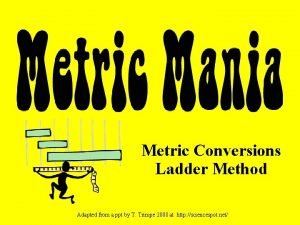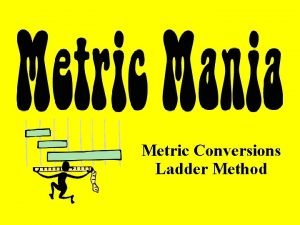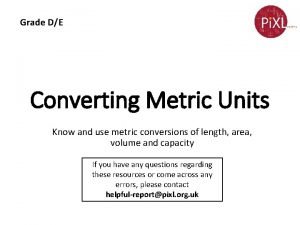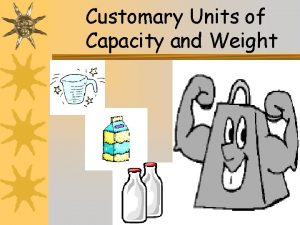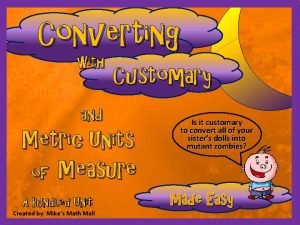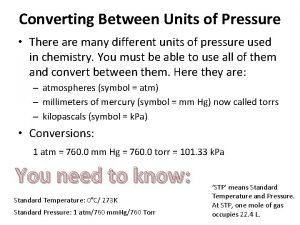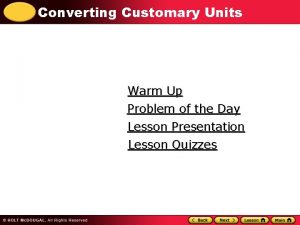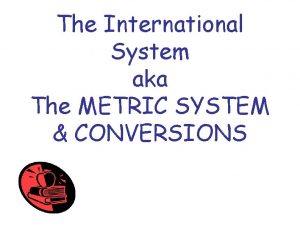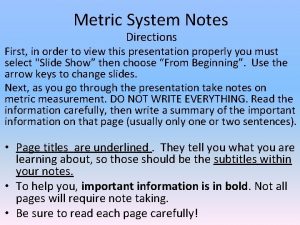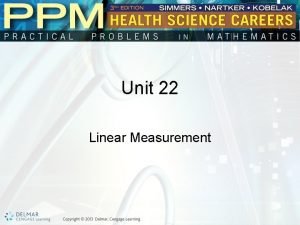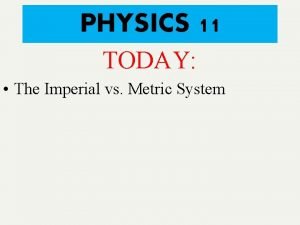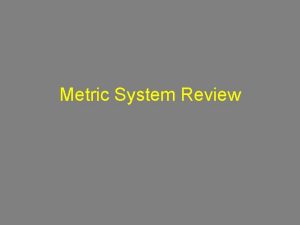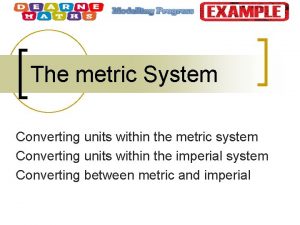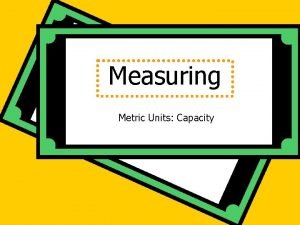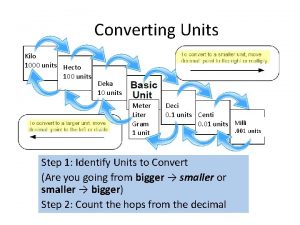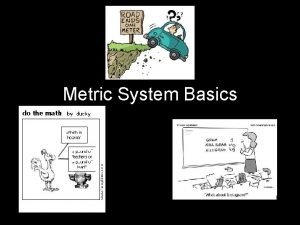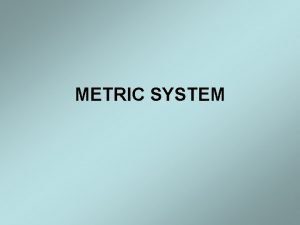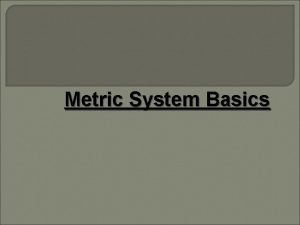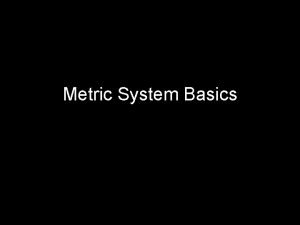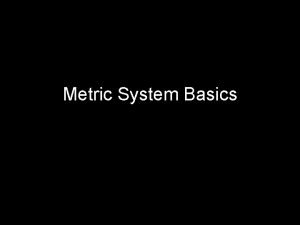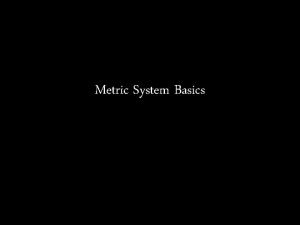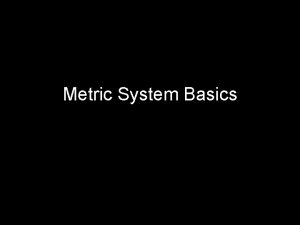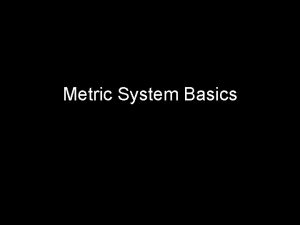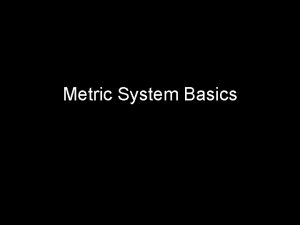Converting Metric Units Copy all green Metric System


















- Slides: 18

Converting Metric Units (Copy all green)

Metric System • The metric system is based on a base unit that corresponds to a certain kind of measurement • Length = meter • Volume = liter • Weight (Mass) = gram • Prefixes plus base units make up the metric system – Example: » Centi + meter = Centimeter » Kilo + liter = Kiloliter

Metric System • The three prefixes that we will use the most are: – kilo – centi – Milli – Kangaroos hop down mountains, lakes and grasslands drinking chocolate milk. Base Units kilo hecto deca meter gram liter deci centi milli

Metric System • So if you needed to measure length you would choose meter as your base unit to measure such things as: – Length of a tree branch – Length of a room – Length of a ball of twine stretched out

Metric System • But what if you need to measure a longer distance, like from your house to school? – you could add a prefix onto the base unit, meter, to make it easier to manage – You would use the kilometer

Metric System • These prefixes are based on powers of 10. What does this mean? – From each prefix every “hop” is either: • 10 times larger or • 10 times smaller – For example • Centimeters are 10 times larger than millimeters • 1 centimeter = 10 millimeters Base Units kilo hecto deca meter gram liter deci centi milli

Metric System – Centimeters are 10 times larger than millimeters so it takes more millimeters for the same length 1 centimeter = 10 millimeters Example not to scale 40 1 mm 41 1 mm 1 mm 40 1 mm 41 1 cm

Begin Activity : Hop The Decimals Assign students prefixes

Remember When Converting… • If no decimal is in the problem given, the decimal is assumed to be behind the last number in the problem • Fill in blank spaces with zeros • Rewrite your final answer with the correct decimal place and commas, as needed

Metric System • For each “hop” to right, you are multiplying by 10 • For example, let’s go from a base unit to centi 1 liter = 10 deciliters = 100 centiliters ( 1 x 10 = 10) = (10 x 10 = 100) 2 grams = 20 decigrams = 200 centigrams (2 x 10 = 20) kilo hecto deca meter liter gram = (20 x 10 = 200) deci centi milli

Metric System • An easy way to move within the metric system is by moving the decimal point one place for each “hop” desired Example: change meters to centimeters 1 meter = 10 decimeters = 100 centimeters or 1. 00 meter = 10. 0 decimeters = 100. centimeters kilo hecto deca meter liter gram deci centi milli

Metric System • example from meters to kilometers: 16093 meters = 1609. 3 decameters = 160. 93 hectometers = 16. 093 kilometers • So for every “hop” from the base unit to kilo, we moved the decimal 1 place to the left (the same direction as in the diagram below) kilo hecto deca meter liter gram deci centi milli

Metric System • If you move (hop) to the left in the diagram, move (hop) the decimal to the left • If you move (hop) to the right in the diagram, move (hop) the decimal to the right kilo hecto deca meter liter gram deci centi milli

Metric System • Now let’s start from centimeters and convert to kilometers 400000 centimeters = 4. 00000 kilometers kilo hecto deca meter liter gram deci centi milli

Metric System • Now let’s start from meters and convert to kilometers 4000 meters = 4 kilometers kilo hecto deca meter liter gram deci centi milli • Now let’s start from centimeters and convert to meters 4000 centimeters = 40 meters kilo hecto deca meter liter gram deci centi milli

Metric System • Now let’s start from meters and convert to centimeters 5 meters = 500 centimeters kilo hecto deca meter liter gram deci centi milli • Now let’s start from kilometers and convert to meters. 3 kilometers = 300 meters kilo hecto deca meter liter gram deci centi milli

Metric System • Now let’s start from kilometers and convert to millimeters 4 kilometers = 4000000 millimeters or 4 kilometers = 40 hectometers = 400 decameters = 40000 decimeters = 400000 centimeters = 4000000 millimeters kilo hecto deca meter liter gram deci centi milli

Metric System • Summary – Base units in the metric system are meter, liter, gram – Metric system is based on powers of 10 – For conversions within the metric system, each “hop” is 1 decimal place to the right or left – Using the diagram below, converting to the right, moves the decimal to the right and vice versa kilo hecto deca meter liter gram deci centi milli
 160 cm to mm
160 cm to mm Metric conversion latter
Metric conversion latter Converting measurements
Converting measurements Converting customary units of capacity
Converting customary units of capacity Conversion ladder
Conversion ladder Converting between units of pressure
Converting between units of pressure Converting customary units of length
Converting customary units of length Show me green
Show me green Km hec dec m dm cm mm
Km hec dec m dm cm mm Metric system notes
Metric system notes English linear measurements
English linear measurements Conversion of units of measurement
Conversion of units of measurement Are all living things based on the metric system
Are all living things based on the metric system Name a line containing point a
Name a line containing point a Speywood units vs botox units
Speywood units vs botox units Income statement for absorption costing
Income statement for absorption costing Basic conversions
Basic conversions What are the 7 metric units?
What are the 7 metric units? English and metric units
English and metric units
